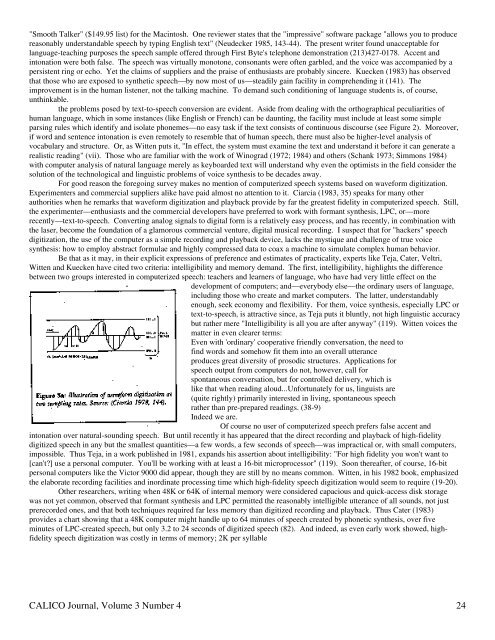MASTER (') S VOICE: THE VICTOR 9000 AND HIGH-FIDELITY ...
MASTER (') S VOICE: THE VICTOR 9000 AND HIGH-FIDELITY ...
MASTER (') S VOICE: THE VICTOR 9000 AND HIGH-FIDELITY ...
Create successful ePaper yourself
Turn your PDF publications into a flip-book with our unique Google optimized e-Paper software.
"Smooth Talker" ($149.95 list) for the Macintosh. One reviewer states that the "impressive" software package "allows you to produce<br />
reasonably understandable speech by typing English text" (Neudecker 1985, 143-44). The present writer found unacceptable for<br />
language-teaching purposes the speech sample offered through First Byte's telephone demonstration (213)427-0178. Accent and<br />
intonation were both false. The speech was virtually monotone, consonants were often garbled, and the voice was accompanied by a<br />
persistent ring or echo. Yet the claims of suppliers and the praise of enthusiasts are probably sincere. Kuecken (1983) has observed<br />
that those who are exposed to synthetic speech—by now most of us—steadily gain facility in comprehending it (141). The<br />
improvement is in the human listener, not the talking machine. To demand such conditioning of language students is, of course,<br />
unthinkable.<br />
the problems posed by text-to-speech conversion are evident. Aside from dealing with the orthographical peculiarities of<br />
human language, which in some instances (like English or French) can be daunting, the facility must include at least some simple<br />
parsing rules which identify and isolate phonemes—no easy task if the text consists of continuous discourse (see Figure 2). Moreover,<br />
if word and sentence intonation is even remotely to resemble that of human speech, there must also be higher-level analysis of<br />
vocabulary and structure. Or, as Witten puts it, "In effect, the system must examine the text and understand it before it can generate a<br />
realistic reading" (vii). Those who are familiar with the work of Winograd (1972; 1984) and others (Schank 1973; Simmons 1984)<br />
with computer analysis of natural language merely as keyboarded text will understand why even the optimists in the field consider the<br />
solution of the technological and linguistic problems of voice synthesis to be decades away.<br />
For good reason the foregoing survey makes no mention of computerized speech systems based on waveform digitization.<br />
Experimenters and commercial suppliers alike have paid almost no attention to it. Ciarcia (1983, 35) speaks for many other<br />
authorities when he remarks that waveform digitization and playback provide by far the greatest fidelity in computerized speech. Still,<br />
the experimenter—enthusiasts and the commercial developers have preferred to work with formant synthesis, LPC, or—more<br />
recently—text-to-speech. Converting analog signals to digital form is a relatively easy process, and has recently, in combination with<br />
the laser, become the foundation of a glamorous commercial venture, digital musical recording. I suspect that for "hackers" speech<br />
digitization, the use of the computer as a simple recording and playback device, lacks the mystique and challenge of true voice<br />
synthesis: how to employ abstract formulae and highly compressed data to coax a machine to simulate complex human behavior.<br />
Be that as it may, in their explicit expressions of preference and estimates of practicality, experts like Teja, Cater, Veltri,<br />
Witten and Kuecken have cited two criteria: intelligibility and memory demand. The first, intelligibility, highlights the difference<br />
between two groups interested in computerized speech: teachers and learners of language, who have had very little effect on the<br />
development of computers; and—everybody else—the ordinary users of language,<br />
including those who create and market computers. The latter, understandably<br />
enough, seek economy and flexibility. For them, voice synthesis, especially LPC or<br />
text-to-speech, is attractive since, as Teja puts it bluntly, not high linguistic accuracy<br />
but rather mere "Intelligibility is all you are after anyway" (119). Witten voices the<br />
matter in even clearer terms:<br />
Even with 'ordinary' cooperative friendly conversation, the need to<br />
find words and somehow fit them into an overall utterance<br />
produces great diversity of prosodic structures. Applications for<br />
speech output from computers do not, however, call for<br />
spontaneous conversation, but for controlled delivery, which is<br />
like that when reading aloud...Unfortunately for us, linguists are<br />
(quite rightly) primarily interested in living, spontaneous speech<br />
rather than pre-prepared readings. (38-9)<br />
Indeed we are.<br />
Of course no user of computerized speech prefers false accent and<br />
intonation over natural-sounding speech. But until recently it has appeared that the direct recording and playback of high-fidelity<br />
digitized speech in any but the smallest quantities—a few words, a few seconds of speech—was impractical or, with small computers,<br />
impossible. Thus Teja, in a work published in 1981, expands his assertion about intelligibility: "For high fidelity you won't want to<br />
[can't?] use a personal computer. You'll be working with at least a 16-bit microprocessor" (119). Soon thereafter, of course, 16-bit<br />
personal computers like the Victor <strong>9000</strong> did appear, though they are still by no means common. Witten, in his 1982 book, emphasized<br />
the elaborate recording facilities and inordinate processing time which high-fidelity speech digitization would seem to require (19-20).<br />
Other researchers, writing when 48K or 64K of internal memory were considered capacious and quick-access disk storage<br />
was not yet common, observed that formant synthesis and LPC permitted the reasonably intelligible utterance of all sounds, not just<br />
prerecorded ones, and that both techniques required far less memory than digitized recording and playback. Thus Cater (1983)<br />
provides a chart showing that a 48K computer might handle up to 64 minutes of speech created by phonetic synthesis, over five<br />
minutes of LPC-created speech, but only 3.2 to 24 seconds of digitized speech (82). And indeed, as even early work showed, highfidelity<br />
speech digitization was costly in terms of memory; 2K per syllable<br />
CALICO Journal, Volume 3 Number 4 24
















